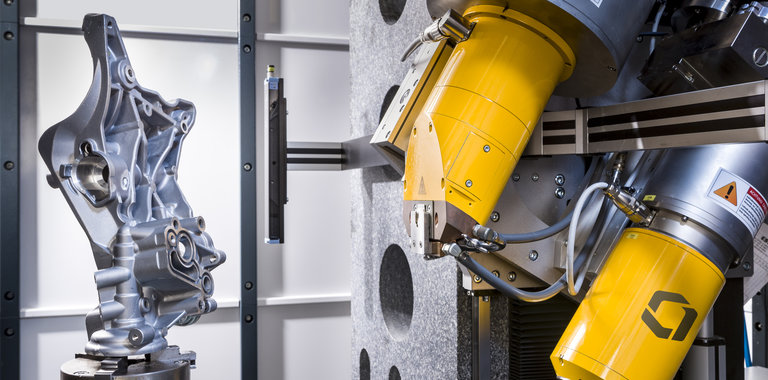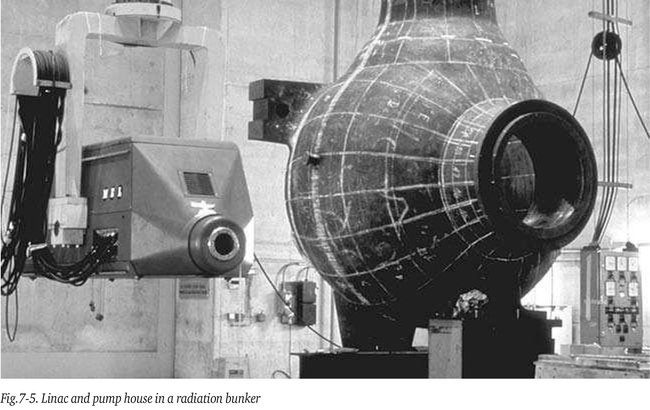
高エネルギー X 線設備はどのように運営されているのか?
The equipment described in the two former sections is used to generate X-radiation up to approximately 450 kV. However, sometimes higher energy levels are needed. Several types of equipment have been built to operate in the 1 MeV to 10 MeV range. In industrial radiography almost exclusively Bètatrons or linear accelerators (linacs) are used. Operating high-energy X-ray installations requires (costly) safety precautions.
The Bètatron: The Bètatron is an electron accelerator, which can produce X-radiation in the 2-30 MeV energy range. The electrons are emitted into a round-sectioned donut shaped glass vacuum tube, as shown in figure 5-5. After several millions of revolutions the electrons reach maximum energy and are deflected towards the target. On the target, part of the electron energy is converted into a tangentially directed beam of X-radiation. To obtain a reasonably high radiation intensity, most Bètatrons have been designed to ope- rate in the 10-30 MeV energy range, as these voltages achieve maximum conversion rate of electron energy into radiation. Even so the output of Bètatrons is usually small compared to linacs. Transportable low energy Bètatrons (2-6 MeV) have been built, but these gene- rally have a low radiation output, which limits their application. One advantage of Bètatrons is that they can be built with very small (micromillimeter) focal spots. A disadvantage is that with these very high energy levels the X-ray beam is usually narrow, and the coverage of larger film sizes is only possible by using increased source-to-film distances. The extended exposure times required can be a practical problem.
The linear accelerator (linac): The energy levels mostly used for linacs (linear accelerators) are 4 MeV and 8 MeV. Linear accelerators can be constructed for one or two energy levels.
In the travelling-wave linac, the acceleration of electrons from a heated filament to very high energies results from the electrons “riding” a high-frequency (3-10 MHz) electromag- netic wave travelling in a straight line down an acceleration tube (the hollow guide). The electrons are bunched into pulses at a frequency of a few hundred pulses per second. The target, which the electrons strike to generate X-radiation, is at the opposite end of the main wave guide of the filament assembly. This is a transmission type target from which the radiation beam passes in a straight line.
The X-ray output from a linear accelerator is many times higher than from a Bètatron of the same energy. An 8 MeV linac with a 2 mm diameter focal spot can deliver a radiation dose rate of 30 Sv/minute at 1 metre distance from the focus. Small light-weight portable linacs of 3 MeV capacity can have outputs of 1.5 Sv/minute at 1 metre distance.
The main properties of a linear accelerator are:
1. very high output of radiation
2. very small focal spot dimensions (<2 mm)
3. considerable weight (approx. 1200 kg for an 8 MeV stationary installation)
この図は、ポンプハウジングを検証する放射線バンカーにおける 8 MeV のリニアックを示しています。




